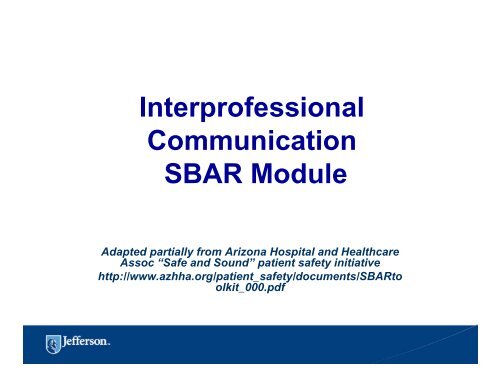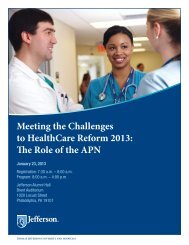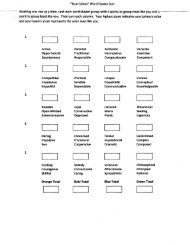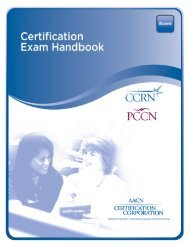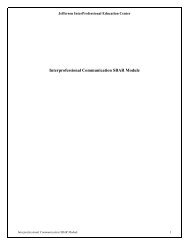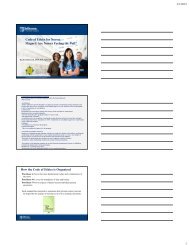Interprofessional Communication SBAR Module - jeffline
Interprofessional Communication SBAR Module - jeffline
Interprofessional Communication SBAR Module - jeffline
Create successful ePaper yourself
Turn your PDF publications into a flip-book with our unique Google optimized e-Paper software.
<strong>Interprofessional</strong><strong>Communication</strong><strong>SBAR</strong> <strong>Module</strong>Adapted partially from Arizona Hospital and HealthcareAssoc “Safe and Sound” patient safety initiativehttp://www.azhha.org/patient_safety/documents/<strong>SBAR</strong>toolkit_000.pdf
<strong>Communication</strong> by G Love & Special SauceBlues and hip hop band originally from Philadelphia, PAI wanna know what your sayin'I wanna know what it's all aboutI want you to spell it out for meNo I'm not a mind readerNo I'm not a heart beaterNo I don't have ESPC-O-M-M-U-N-I-C-A-T... I-O-N(c'mon let's sing it now)communication, communication, communication with me•
Objectives of sessionAt the end of the session, participants will beable to:1. Discuss the benefits of interprofessionalcommunication and collaboration in enhancingpatient care safety and outcomes.2. Identify the <strong>SBAR</strong> method as an evidencebased model.3. Apply a communication technique using casescenarios.
<strong>Communication</strong> among healthprofessionals• What are some “barriers” to goodcommunication in the health care setting?• What are some “facilitators” to goodcommunication in the health care setting?
BACKGROUND• Some studies indicate that 70-80% of medicalerrors are related to interpersonal interactionissues.Agency for Healthcare Research and Quality January 2004http://www.ahrq.gov/RESEARCH/jan04/0104RA25.htm• It has been noted that in 63% of JCAHOsentinel event occurrences, communicationbreakdown is the leading root cause.Joint Commission Perspectives on Patient Safety, Volume 2, Number 9,September 2002 , pp. 4-5(2)
BACKGROUNDPoor communication has also beenidentified as the primary factor of bothmedical malpractice claims and majorpatient safety violations, includingerrors resulting in patient death.Hospitals and Health Networkhttp://www.hhnmag.com/hhnmag_app/jsp/articledisplay.jsp?dcrpath=HHNMAG/Pubs NewsArticle/data /2006August
BACKGROUNDOne study found nurse/physiciancommunication style was the leadingpredictor of patient mortality inintensive care units.Knaus et al, 1986, Annals on Internal Medicine
BACKGROUNDGood collaboration between physiciansand nurses was related to better patientoutcomes in ICUsBaggs et al, 1992, Heart and Lung
BACKGROUNDAnother study demonstrated that thedegree of collaboration betweensurgeons, anesthesiologists, andnurses correlates with risk-adjustedmorbidity and mortality.Young et al, 1997, Health Care Management Review
Ambulatory chronic disease patients sufferpreventable medical errorsPatient Safety Monitor Alert, July 29, 2009Journal on Quality and Patient Safety highlighted astudy at UCSF that identified the gaps in thehealthcare system to which ambulatory patients withchronic disease are exposed. They found that unlikein hospital settings in which patients are managedby a team of caregivers during their stay, ambulatorypatients are often managed by many differentcaregivers with a lack of defined protocols.Additionally, the researchers found that medicalerrors sometimes occurred because of the lack ofcommunication among ambulatory patients'health providers, as well as patients being unawareof their own medication regimens.
Patient Safety Monitor Alert (9/16/09)• Patients of the future will demand increasedcommunication and will be more informedconsumers• In the future, healthcare providers can expectmore informed patients who want their careteam members to be open to communicatingvia e-mail and other Internet platforms. Theywill also be more knowledgeable aboutpotential treatment options, their own healthrecords, and ask upfront about the costs thatwill be incurred with medical care.
The Joint Commission justreleased the 2010 NationalPatient Safety Goals (NPSG)early October 2009.The Joint Commission has includedpatient hand-offs as a part of itsNational Patient Safety Goals for years
Hand-off <strong>Communication</strong>A 2005 study found that nearly 70% ofpreventable hospital mishaps occurredbecause of communication problemsand other studies have shown that atleast half of such breakdowns occurduring hand-offs.
The Wall Street Journal6/28/06For hospitals, the “hand-off”has long been the BermudaTriangle of health care.
Examples of hand-offcommunications include:• Transition of Care reports – such as a PACU toSurgical Floor, CICU to Telemetry, Labor andDelivery to Post Partum and ED to medical floor• Shift to Shift report; Charge Nurse to Charge Nurse• Physician to Physician• Health professional to health professional
JCAHOJoint Commission has issued several NationalPatient Safety Goals specific to communication, butthey are not prescriptive in how to meet the goal.NPSG 2A through 2E deal with communicationissues.2E: Implement a standardized approach to “handoff” communications, including an opportunity toask and respond to questions.
Hospital uses electronic medical record to improvehand-off processPatient Safety Monitor, April 1, 2009Staff members at Abington (PA) Memorial Hospital (AMH) knew theirhand-off process could use some work. Their process, like that ofmany other hospitals, used a paper form to communicate importantpatient information from one provider of care to the next often puttingthe patient at risk for an error in care. The hospital also needed to stayin compliance with National Patient Safety Goal 02.05.01, concerninghand-off communication.Additionally, nurses often had to double-document information on thehand-offs that was already captured in the electronic medical record(EMR). AMH had implemented computer physician order entry andclinical documentation by September 2007 and decided to utilize theEMR to enhance its hand-off process.We thought maybe we could use that type of technology to get better,more accurate information in a simple way to ancillary staff, saysDiane Humbrecht, MSN, RN, C, nurse director of informatics at AMH.
Method to reduce “hand offs”In 2007, Cedars-Sinai Medical Center in Los Angeles rolledout a “universal floor” during an expansion project.Cedars-Sinai’s innovation has since lowered wait times forpatients being admitted from the ED and elsewhere,reduced the number of patient safety events, andincreased staff member satisfaction.A universal floor is one on which most patientconsultations can take place. Rooms are created withmultiple types of patient care in mind, and staff membersare trained in many specialties to facilitate patients’ needson one floor, reducing the need for patients to travelthroughout the hospital.
JCAHO standardNPSG 2E: Implement a standardizedapproach to “hand off”communications, including anopportunity to ask and respond toquestions.An example of a standardized approachis the <strong>SBAR</strong> method
<strong>SBAR</strong>• S – Situation: What is happening at thepresent time?• B – Background: What are thecircumstances leading up to this situation?• A – Assessment: What do I think theproblem is?• R – Recommendation: What should wedo to correct the problem?
<strong>SBAR</strong> history<strong>SBAR</strong> has been used in several other highrisk industries successfully and has anevidence-based background.– Used in nuclear submarines in US Navy and usedin the airline industry. Following investigation ofairline crashes in 1970s, the primary cause wasdetermined to be a breakdown in communicationbetween the pilots in the cockpit. From then, theairline industry made a commitment to reduceairline accidents by developing a comprehensivesafety program and <strong>SBAR</strong> is one component ofthis program.
Nurses comments on <strong>SBAR</strong>Veteran nurses use <strong>SBAR</strong> because it givesthem “permission” to make arecommendation.It also reinforces the concept of “we’re ateam and what I have to say is significant.”
Newly Graduated Nurses’comments on <strong>SBAR</strong>They appreciate <strong>SBAR</strong> because it is a toolthat helps them become organized andmore confident when discussing situationswith others.Using <strong>SBAR</strong> guides them through asystematic communicative approach toorganize their information.
Physician comments on <strong>SBAR</strong>“When a nurse uses <strong>SBAR</strong>, physicians often say,‘This is great. The nurse gets straight to the point,has all the essential pieces of information and Iknow what they are asking for.’ The guessing gameis omitted.” Why is this? It may go back to training.Nurses are trained to write care plans morenarrative in nature. Physicians, however, aretrained to use “headlines” or bullet point notations.As a result, there are differing approaches whencommunicating.
<strong>SBAR</strong> introductionYouTube video• http://www.youtube.com/watch?v=HAdkcC4pdMQ
Perinatal <strong>SBAR</strong> document• Review the 30-60 second Perinatal<strong>SBAR</strong> form used at Holy Cross Hospitalin Arizona.• Shows examples of use with OBpatients and Newborn/Pediatrics
Pediatric <strong>SBAR</strong> use locallyMany of the local pediatric sitesassigned for nursing pediatric rotationuse a variation of <strong>SBAR</strong> for theircommunications/hand-offs.They use I<strong>SBAR</strong>Q: I (Introduction) is forpatient demographics and Q(Questions) is for clarificationquestions if needed.
Scenarios to practicein small groups• Take turns being the speaker and the listener• Use the <strong>SBAR</strong> practice sheets distributed (add info to scenarioif needed)• Begin all communications with:– two identifiers in the process. For example, say “This report isabout Bob Henry, DOB 2/24/60”• End all communications with:– What questions do you have for me– “I am here until (insert time). If you have questions later on, callext. and ask for me, (insert name).”
Discussion• What was the process like using the <strong>SBAR</strong> technique?• What specifically did you learn about physician-nursecollaboration?• Share a personal example of interprofessionalcommunication that could have been positive ornegative.• Earlier we discussed barriers and facilitators tocommunication, do you have any additions to add toeither barriers or facilitators?• Based on today’s session, how will you use <strong>SBAR</strong> inupcoming clinical rotations?
www.<strong>jeffline</strong>.jefferson.edu/jcipeTHANK YOU


